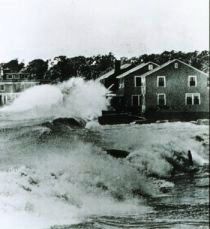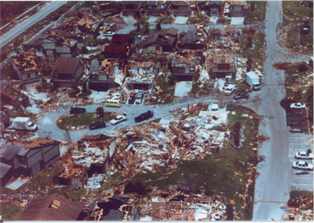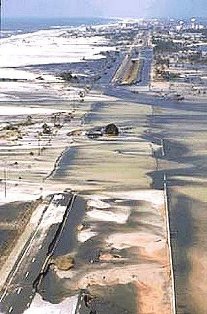Discover Florida Nature
It's time to explore the natural Florida


|
|
|
|
|
|
In the period between 1950 and 1974, 85 tropical or subtropical cyclones
impacted the state, which collectively resulted in about $6.2 billion
(2008 USD) in damage, primarily from Hurricanes Donna and Dora.
Additionally, the storms were directly responsible for 93 fatalities and
indirectly for 23 more deaths. Several tropical cyclones produced over
20 inches (500 mm) of rainfall in the state, including Hurricane Easy,
which is the highest total during the period. The 1969 season was the
year with the most tropical cyclones affecting the state, with a total
of 8 systems. The 1954 and 1967 seasons were the only years during the
period in which a storm did not affect the state. The strongest
hurricane to hit the state during the period was Hurricane Donna, which
was the 8th strongest hurricane on record to strike the United States.
Additionally, Hurricanes Easy, King, Hurricane Cleo Isbell, and Betsy
hit the state as major hurricanes. In the period between 1975 and 1999, 83 tropical or subtropical cyclones affected the state, which collectively resulted in $45 billion (2008 USD) in damage, primarily from Hurricane Andrew, and 54 direct casualties. The 1985 season was the year with the most tropical cyclones affecting the state, with a total of 8 systems. Every year included at least 1 tropical cyclone affecting the state. The strongest hurricane to hit the state during the period was Hurricane Andrew, which was one of only three Category 5 hurricanes to strike the United States. Andrew, at the time, was the costliest tropical cyclone in United States history and remains the second-costliest. Additionally, Hurricanes Eloise Hurricane David and Hurricane Opal hit the state as major hurricanes.  Hurricane
Donna- (1960) After swiping the Florida Keys and striking land
near Fort Myers on Sept. 10, 'Deadly Donna' did not travel along the
usual path that storms of her magnitude usually take. Instead of heading
back to the Atlantic Ocean or the Gulf of Mexico, Donna took on the
unusual distinction of being the only hurricane of record to produce
hurricane-force winds throughout the U.S. East Coast from Florida, the
Mid-Atlantic states and New England. The hurricane's center passed
through 60 miles west of Miami, sparing Broward County.
This time, Broward residents only experienced 80 mile-per-hour winds as
Donna's fringes passed by, causing a few trees and signs to tumble down.
Unfortunately, residents in the Florida Keys fared worse, having to
endure 13-foot storm surges and 150 mile-per-hour winds. Bridges were
washed away and homes resembled splintered matchsticks for miles. The
Fort Lauderdale
News reported that the Tampa Weather Bureau predicted statewide
property damage to reach $2 billion. Hurricane Donna was the
fifth-strongest hurricane of record to hit the U.S., causing 50 deaths,
$387 million in property damage and affected over 50 million people
according to the National Hurricane Center. Hurricane
Donna- (1960) After swiping the Florida Keys and striking land
near Fort Myers on Sept. 10, 'Deadly Donna' did not travel along the
usual path that storms of her magnitude usually take. Instead of heading
back to the Atlantic Ocean or the Gulf of Mexico, Donna took on the
unusual distinction of being the only hurricane of record to produce
hurricane-force winds throughout the U.S. East Coast from Florida, the
Mid-Atlantic states and New England. The hurricane's center passed
through 60 miles west of Miami, sparing Broward County.
This time, Broward residents only experienced 80 mile-per-hour winds as
Donna's fringes passed by, causing a few trees and signs to tumble down.
Unfortunately, residents in the Florida Keys fared worse, having to
endure 13-foot storm surges and 150 mile-per-hour winds. Bridges were
washed away and homes resembled splintered matchsticks for miles. The
Fort Lauderdale
News reported that the Tampa Weather Bureau predicted statewide
property damage to reach $2 billion. Hurricane Donna was the
fifth-strongest hurricane of record to hit the U.S., causing 50 deaths,
$387 million in property damage and affected over 50 million people
according to the National Hurricane Center. Hurricane
Andrew- (1992) Andrew was a small and ferocious Cape Verde
hurricane that wrought unprecedented economic devastation along a path
through the northwestern Bahamas, the southern Florida peninsula, and
south-central Louisiana. On August 24, Andrew struck Elliott Key with
winds of 165 miles per hour and a pressure of 926 mbar. The hurricane
continued to strengthen up to and slightly after landfall, and
25 minutes after its first Florida landfall Andrew hit near Homestead
with a slightly lower pressure and winds of 150 mph. Hurricane Andrew
slammed into South Florida, devastating Homestead, Florida City and
parts of Miami, then continued northwest across the Gulf of Mexico to
strike the
Louisiana coastline. In all, the storm caused 15 deaths directly,
25 deaths indirectly and $30-billion in property damage, making it the
costliest disaster in U.S history. More than 250,000 people were left
homeless; 82,000 businesses were destroyed or damaged; about 100,000
residents of south Dade County permanently left the area in Andrew's
wake. Andrew also had a severe impact on the environment -- it damaged
33 percent of the coral reefs at Biscayne National Park, and 90 percent
of South Dade's native pinelands, mangroves and tropical hardwood
hammocks. It also created 30 years worth of debris. Hurricane
Andrew- (1992) Andrew was a small and ferocious Cape Verde
hurricane that wrought unprecedented economic devastation along a path
through the northwestern Bahamas, the southern Florida peninsula, and
south-central Louisiana. On August 24, Andrew struck Elliott Key with
winds of 165 miles per hour and a pressure of 926 mbar. The hurricane
continued to strengthen up to and slightly after landfall, and
25 minutes after its first Florida landfall Andrew hit near Homestead
with a slightly lower pressure and winds of 150 mph. Hurricane Andrew
slammed into South Florida, devastating Homestead, Florida City and
parts of Miami, then continued northwest across the Gulf of Mexico to
strike the
Louisiana coastline. In all, the storm caused 15 deaths directly,
25 deaths indirectly and $30-billion in property damage, making it the
costliest disaster in U.S history. More than 250,000 people were left
homeless; 82,000 businesses were destroyed or damaged; about 100,000
residents of south Dade County permanently left the area in Andrew's
wake. Andrew also had a severe impact on the environment -- it damaged
33 percent of the coral reefs at Biscayne National Park, and 90 percent
of South Dade's native pinelands, mangroves and tropical hardwood
hammocks. It also created 30 years worth of debris. Hurricane
Opal- (1995) When Hurricane Opal hit the Florida Panhandle in
October 1995 - it was the first major hurricane to visit the region in
20 years. Although Opal was barely a major hurricane - in a weakening
mode - when the eye crossed the coast, property damage was rather
severe. Most of the new housing and commercial developments had yet to
experience a storm of Opal's magnitude. The 8 to 14 foot storm surge did
most of the damage, destroying hundreds of structures along the coast.
Hurricane Opal originated from an area of disturbed weather to the east
of Cozumel, Mexico in late September. Passing over the Yucatan
Peninsula, Opal reached tropical storm strength on September 30 in the
southwestern Gulf of Mexico. Opal reached hurricane intensity on October
2nd, and begin a slow northward motion in response to an upper level
trough. As Opal headed toward the northeast Gulf coast, the hurricane
strengthened at a frightening rate. By early the next day, aircraft
reported the pressure had fallen to 916 mb, and sustained winds had
increased to 150 mph. Opal, now almost a category 5 hurricane, was
located 250 miles southwest of Pensacola, Florida. Opal weakened greatly
in the final 8 hours before landfall, although still coming ashore at
the lower end of a major hurricane. Sustained winds of 115 mph, with
gusts to 140 mph, occurred across a short stretch of coastline between
Destin and Panama City, Florida. Outside of the narrow stretch of
coastline, winds of 80 to 100 mph were experienced. Hurlburt Air Field,
near the eye of Opal, recorded 92 mph winds, gusting to 144 mph. Hurricane
Opal- (1995) When Hurricane Opal hit the Florida Panhandle in
October 1995 - it was the first major hurricane to visit the region in
20 years. Although Opal was barely a major hurricane - in a weakening
mode - when the eye crossed the coast, property damage was rather
severe. Most of the new housing and commercial developments had yet to
experience a storm of Opal's magnitude. The 8 to 14 foot storm surge did
most of the damage, destroying hundreds of structures along the coast.
Hurricane Opal originated from an area of disturbed weather to the east
of Cozumel, Mexico in late September. Passing over the Yucatan
Peninsula, Opal reached tropical storm strength on September 30 in the
southwestern Gulf of Mexico. Opal reached hurricane intensity on October
2nd, and begin a slow northward motion in response to an upper level
trough. As Opal headed toward the northeast Gulf coast, the hurricane
strengthened at a frightening rate. By early the next day, aircraft
reported the pressure had fallen to 916 mb, and sustained winds had
increased to 150 mph. Opal, now almost a category 5 hurricane, was
located 250 miles southwest of Pensacola, Florida. Opal weakened greatly
in the final 8 hours before landfall, although still coming ashore at
the lower end of a major hurricane. Sustained winds of 115 mph, with
gusts to 140 mph, occurred across a short stretch of coastline between
Destin and Panama City, Florida. Outside of the narrow stretch of
coastline, winds of 80 to 100 mph were experienced. Hurlburt Air Field,
near the eye of Opal, recorded 92 mph winds, gusting to 144 mph.
|
|
|
Advertise | Privacy Statement | Dog Encyclopedia | Video |Contact | Alaska Nature |
|